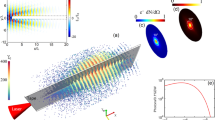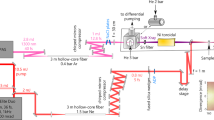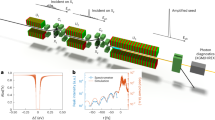Abstract
Ultrafast structural dynamics in the condensed phase represents a key topic of current physics, chemistry and materials science. Femtosecond hard X-ray pulses are important structure probes that have been applied in time-resolved X-ray absorption and diffraction1,2,3,4. Optical pump/X-ray probe schemes with compact laser-driven table-top sources5,6,7,8,9,10,11 have allowed for tiny changes of diffracted intensity to be measured with X-ray photon statistics, which has set the ultimate sensitivity limit12,13,14. To address the strong quest for a higher X-ray flux, here we present the first hard X-ray plasma source driven by intense mid-infrared sub-100-fs pulses at 3.9 μm. The comparably long optical period allows for accelerating electrons from the Cu target to very high kinetic energies and for generating a characteristic Kα flux of 109 photons per pulse, 25 times more than with our 800 nm driver9,10. Theoretical simulations account for the experimental results in a wide range of driving fields and predict a further enhancement of X-ray flux.
This is a preview of subscription content, access via your institution
Access options
Subscribe to this journal
Receive 12 print issues and online access
$209.00 per year
only $17.42 per issue
Buy this article
- Purchase on Springer Link
- Instant access to full article PDF
Prices may be subject to local taxes which are calculated during checkout



Similar content being viewed by others
References
Bressler, C. & Chergui, M. Ultrafast X-ray absorption spectroscopy. Chem. Rev. 104, 1781–1812 (2004).
Rousse, A. et al. Femtosecond X-ray crystallography. Rev. Mod. Phys. 73, 17–31 (2001).
Bargheer, M., Zhavoronkov, N., Woerner, M. & Elsaesser, T. Recent progress in ultrafast X-ray diffraction Chem. Phys. Chem. 7, 783–792 (2006).
Bostedt, C. et al. Ultra-fast and ultra-intense X-ray sciences; first results from the Linac Coherent Light Source free-electron laser. J. Phys. B 46, 164003–164023 (2013).
Brunel, F. Not so resonant, resonant absorption. Phys. Rev. Lett. 59, 52–55 (1987).
Murnane, M. M. et al. Ultrafast X-ray pulses from laser-produced plasmas. Science 251, 531–536 (1991).
Korn, G. et al. Ultrashort 1-kHz laser plasma hard X-ray source. Opt. Lett. 27, 866–868 (2002).
Jiang, Y., Lee, T., Li, W., Ketwaroo, G. & Rose-Petruck, C. G. High-average-power 2-kHz laser for generation of ultrashort X-ray pulses. Opt. Lett. 27, 963–965 (2002).
Zhavoronkov, N. et al. Microfocus Cu Kα source for femtosecond X-ray science. Opt. Lett. 30, 1737–1739 (2005).
Zamponi, F. et al. Femtosecond hard X-ray plasma sources with a kilohertz repetition rate. Appl. Phys. A 96, 51–58 (2009).
Lu, W. et al. Optimized Kα X-ray flashes from femtosecond-laser-irradiated foils. Phys. Rev. E 80, 026404 (2009).
Zamponi, F. et al. Ultrafast large-amplitude relocation of electronic charge in ionic crystals Proc. Natl Acad. Sci. USA 109, 5207–5212 (2012).
Stingl, J. et al. Electron transfer in a virtual quantum state of LiBH4 induced by strong optical fields and mapped by femtosecond X-ray diffraction. Phys. Rev. Lett. 109, 147402 (2012).
Juvé, V. et al. Field-driven dynamics of correlated electrons in LiH and NaBH4 revealed by femtosecond X-ray diffraction. Phys. Rev. Lett. 111, 217401 (2013).
Yalunin, S. V., Gulde, M. & Ropers, C. Strong-field photoemission from surfaces: theoretical approaches. Phys. Rev. B 84, 195426 (2011).
Lewenstein, M., Balcou, P., Ivanov, M. Y., L'Huillier, A. & Corkum, P. B. Theory of high-harmonic generation by low-frequency laser fields. Phys. Rev. A 49, 2117–2132 (1994).
Andriukaitis, G. et al. 90 GW peak power few-cycle mid-infrared pulses from an optical parametric amplifier. Opt. Lett. 36, 2755–2757 (2011).
Zhavoronkov, N., Gritsai, Y., Korn, G. & Elsaesser, T. Ultra-short efficient laser-driven hard X-ray source operated at a kHz repetition rate. Appl. Phys. A 79, 663–667 (2004).
Hubbell, J. H. & Seltzer, S. M. Tables of X-ray mass attenuation coefficients and mass energy-absorption coefficients (National Institute of Standards and Technology, 1996).
Fourmaux, S., Serbanescu, C., Kincaid, R. E. Jr, Krol, A. & Kieffer, J. C. Kα X-ray emission characterization of 100 Hz, 15 mJ femtosecond laser system with high contrast ratio. Appl. Phys. B 94, 569–575 (2009).
Joy, D. C. An introduction to Monte Carlo simulations. Scanning Microsc. 5 329–337 (1991).
Llovet, X. et al. Measurements of K-shell ionization cross sections of Cr, Ni and Cu by impact of 6.5–40 keV electrons. J. Phys. B 33, 3761–3772 (2000).
Acknowledgements
The Max-Born-Institut's group acknowledges financial support from the European Research Council under the European Union's Seventh Framework Programme (FP/2007-2012)/ERC Grant Agreement 247051 and the Deutsche Forschungsgemeinschaft (Grant WO 558/13-1). The Photonics Institute acknowledges the Austrian SFB 49 Next Lite and Project I557, both funded by the Austrian Science Fund (FWF).
Author information
Authors and Affiliations
Contributions
M.W., T.E. and A.B. designed the experiment. J.W., V.J., M.H., S.K., S.A. and A.P. performed the experiments. J.W., V.J., M.H. and S.K. carried out the data analysis. J.W. and M.W. devised the theoretical framework and performed the simulations. V.J., M.W. and T.E. wrote the manuscript, to which all authors suggested improvement.
Corresponding authors
Ethics declarations
Competing interests
The authors declare no competing financial interests.
Supplementary information
Supplementary information
Supplementary information (PDF 361 kb)
Rights and permissions
About this article
Cite this article
Weisshaupt, J., Juvé, V., Holtz, M. et al. High-brightness table-top hard X-ray source driven by sub-100-femtosecond mid-infrared pulses. Nature Photon 8, 927–930 (2014). https://doi.org/10.1038/nphoton.2014.256
Received:
Accepted:
Published:
Issue Date:
DOI: https://doi.org/10.1038/nphoton.2014.256
This article is cited by
-
Experimental investigation of size broadening of a Kα x-ray source produced by high intensity laser pulses
Scientific Reports (2021)
-
Efficient generation of relativistic near-single-cycle mid-infrared pulses in plasmas
Light: Science & Applications (2020)
-
Megafilaments in the mid-infrared
Nature Photonics (2019)
-
Characterization of hard X-ray sources produced via the interaction of relativistic femtosecond laser pulses with metallic targets
Applied Physics B (2019)
-
Emission and dose characterization of the 1 kHz repetition rate high-Z metal K \(_{\alpha }\) α source driven by 20 mJ femtosecond pulses
Applied Physics B (2019)



